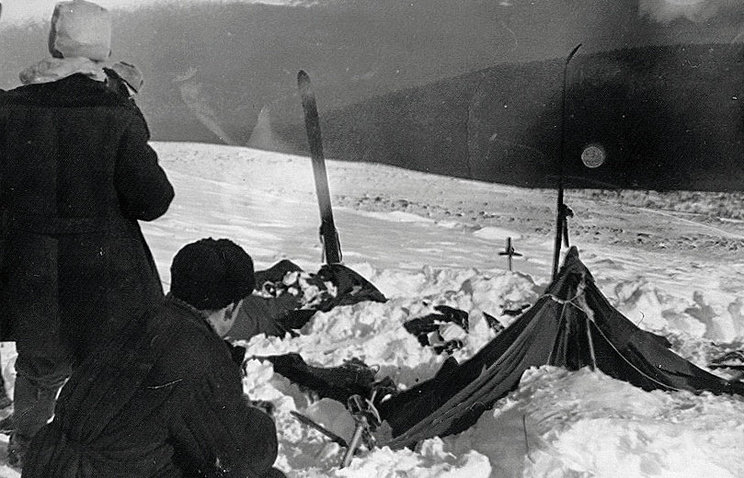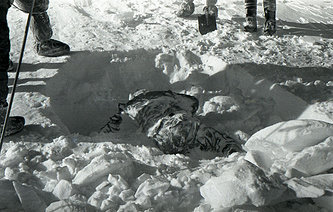
This conclusion is based on recent information about the ties between the KGB and the Dyatlov expedition members who died under bizarre circumstances near the remote Otorten Mountain in the North Urals overnight to February 2, 1959, the researcher said.
"It turned out that there were two KGB officers in the Dyatlov group. Quite possibly, they were carrying out a mission to provide support for a technology-induced experiment. The tourists were carrying a large batch of photo equipment, which was completely atypical of highly complex expeditions that require maximally alleviating their load," Kuntsevich said.
According to the researcher, the tourist group was tasked with reaching Otorten Mountain - translated as the Mountain of the Dead from the local Mansi language - at a definite time. With this in mind, the Dyatlov hikers specifically started the climb after the lunch, stowing away food and setting off light-handed.
"Most likely, the tourists reached their intended destination and waited for a technology-induced moment, which they were apparently expected to capture with photos. But it went off in an unplanned and extraordinary way, which was possibly the cause for the death of the group's members. They, of course, courageously held on to the last and didn't run away or panic," the researcher said.
In the researcher's opinion, the version of the group's having ties with the KGB is also supported by the fact that only four of the ten rolls of film from all the cameras have remained and it is unknown what happened to the rest.
"One film captures the trace of a technology-induced phenomenon - a glowing ball. Besides, each member of the Dyatlov group kept a diary but only three or four of them have survived. All these factors confirm ties with the KGB: they were not simply hikers: they had been sent to the mountain pass on a special mission. This can be confirmed by authorized ID held by the group's head," Kuntsevich said.
The new data will be entered into an almanac, which Kuntsevich plans to publish together with his colleagues in late August or early September.
"We have already submitted it to be printed but we are planning a presentation for it at the beginning of the new academic year. The almanac will consist of two volumes and will separately feature a photo album and have a total of over 1,000 pages. This publication will help to push aside all unnecessary or outlandish versions, such as a mystical scenario or an Abominable Snowman's attack," the scientist said.
The Dyatlov Group Memory Public Fund intends to request official investigators relaunch a probe into the hikers' deaths, as well as search the archives of the KGB successor, the Federal Security Service (FSB) to get missing data that can confirm the version of a man-made disaster.
A memorial plaque was inaugurated on July 19 in Solikamsk, in the Ural's Perm Region, dedicated to Yuri Yudin, the expedition's tenth member who had survived. During the hiking, he had to leave the group after an acute pain in his leg, which helped make him the solely surviving member of the Dyatlov group. He was the first to identify the personal belongings of the dead expedition members. Up until his last days, he maintained close contacts with the researchers investigating the causes of the Dyatlov group's deaths.
Dyatlov group mystery
The mountain pass was named after Dyatlov, the head of the expedition, which planned to ascend to the 1,079-meter summit in the Sub-Arctic Urals. Dyatlov and the other eight members of his group died at the pass near Otorten Mountain during the early morning hours of February 2, 1959 under mysterious circumstances. The expedition members were found frozen to death with numerous signs of bodily injuries and without outdoor clothes or footwear. Eventually, dozens of versions arose as to what happened at the mountain pass, including completely bizarre theories of an attack by an abominable snowman or an encounter with aliens.
According to the official forensic study, most of the hikers froze to death but some were found with serious injuries that caused their death. Various versions of the incident were considered, including an avalanche hitting their tent, an attack by fugitive prisoners, their deaths from an attack by the indigenous Mansi inhabitants or even a brawl among the group members.
The Dyatlov Group Memory Fund has been in existence since July 2000. The Fund has been carrying out its own investigation over all these years into the causes of the Dyatlov group's deaths, constantly replenishing its archive with new first-hand data from friends, searching participants and other eye-witnesses who have kept silent for many years.




Comment: More stories on this case: